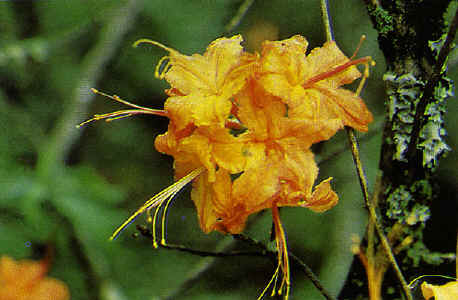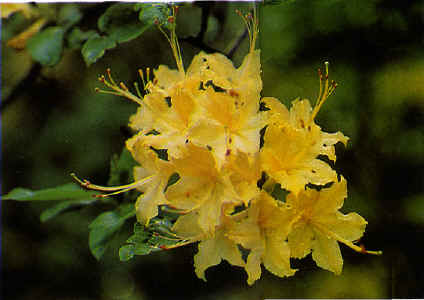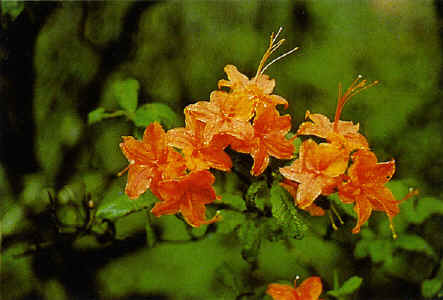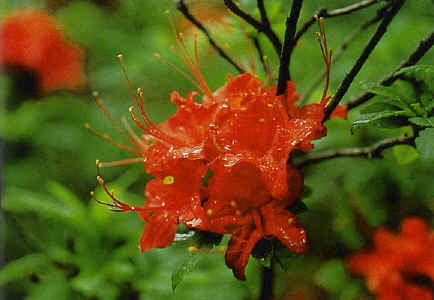Native Azaleas: Wayah Bald
Dr. H. Furman Cantrell, Piedmont, S. C.
There is a growing number of areas in the mountainous regions of the southeastern states where outstanding natural collections of native deciduous azaleas are being discovered and enjoyed. One area that is fairly well known and is being enjoyed by more and more people is Wayah Bald, located near Franklin, N. C. The elevation is about 5,000 feet, and the summit is easily reached by car. The Appalachian Trail passes over the summit also, and numerous hikers pass through the area each year. Whether you arrive by car or on foot, you will find a magnificent display of color during the latter part of June.
The secondary road to the summit is bordered almost continuously by hundreds or even thousands of large, almost tree-like native azaleas. This display begins soon after entering the secondary road to the summit, and seems to grow more beautiful as you drive along. The azaleas extend beyond the edge of the road into the wooded area of the forest. It is often complemented by native ferns, wildflowers and trickling streams. The majority of the azaleas bordering the road are forms of
R. calendulaceum
. However, there are occasional plants of
R. arborescens
mixed in along with beautiful plants of
Kalmia
. At the summit, one finds a large area covered with
R. arborescens
.

|

|
| R. calendulaceum | R. calendulaceum |

|

|
|
| R. calendulaceum | R. calendulaceum | |
| All photos by Dr. H. Furman Cantrell | ||
The
R. calendulaceum
offers a wide range of color from yellow to orange to red with many intergrades of these colors. This variation of color is accented by variation of size and shape of flowers. Adding to this spectacular display of color is the uniqueness of bi-colors of light and dark yellow or orange and yellow with orange. Much of this display is visible from one's vehicle. This factor makes the area enjoyable for those who are unable to hike to some of the more remote areas where the native azaleas are found.
The
R. arborescens
can be seen from the footpaths along the summit, and. provide a beautiful carpet of white, pink and red as well as a fragrance so characteristic of this species. There are hundreds of plants of
R. arborescens
covering the summit and one gets the feeling of floating on a sea of
R. arborescens
. This past summer, several plants of
R. arborescens
with a distinct yellow pigment were located in this area.
A visit to Wayah during the flower season has become a regular event for many of our chapter members because of the very beautiful display and the relative ease of getting to enjoy it. We also return in the late fall to collect seed capsules for our own use and to send to the ARS Seed Exchange. A supply of seed from the
R. calendulaceum
"complex" (the entire range of colors) and the
R. arborescens
"complex" will be available for the 1980 ARS Seed Exchange from a collecting trip made by the author. Although the flowers are absent in November, the plants possess a unique beauty in the bare twigs, flower buds and seed capsules. For me, this is just one more element of beauty that these plants provide. If you can not get there to see them, why not grow some Wayah seedlings and create a little Wayah in your own garden.